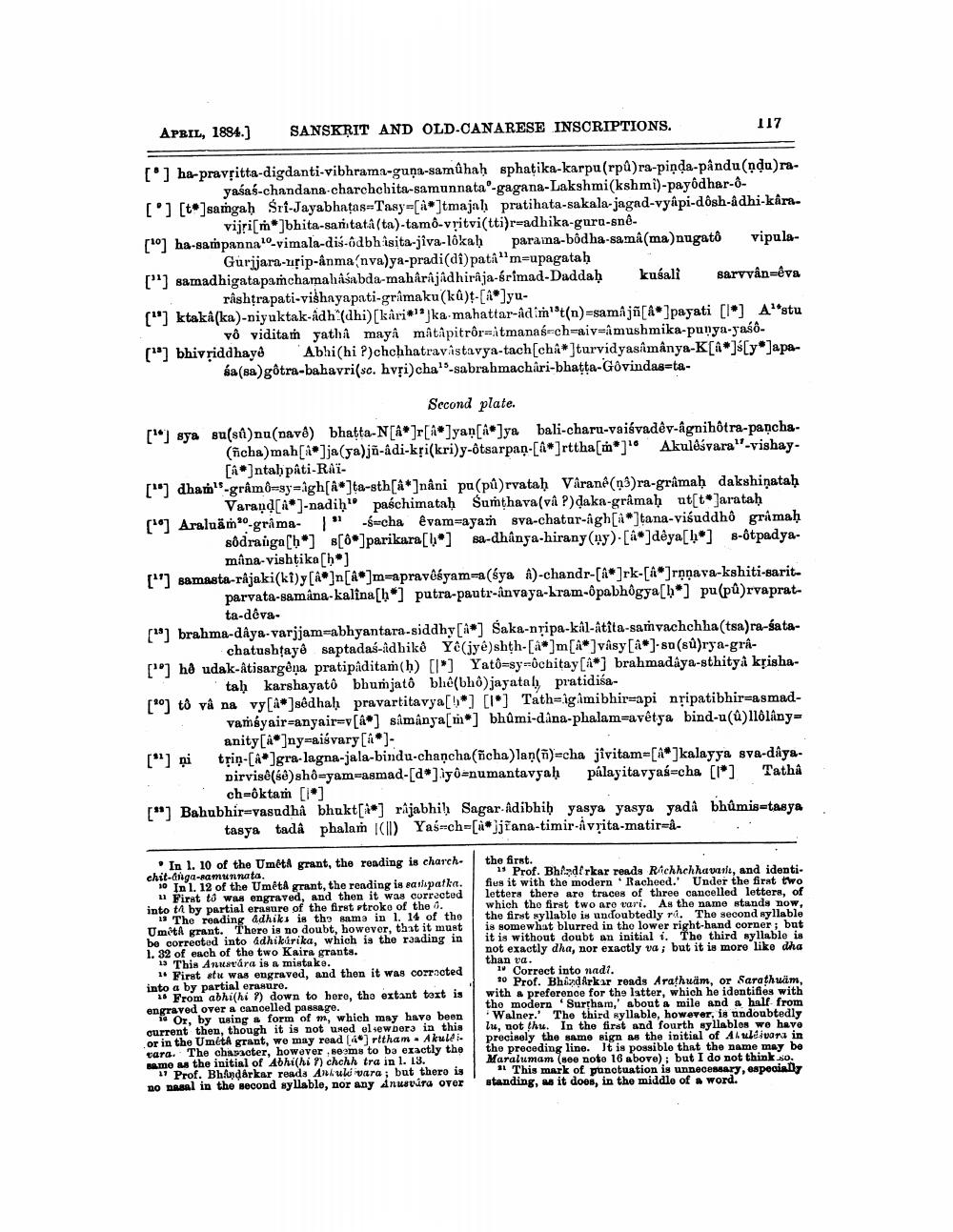________________
APBIL, 1884.)
SANSKRIT AND OLD-CANARESE INSCRIPTIONS.
117
[] ha-pravritta-digdanti-vibhrama-guna-samûhah sphatika-karpu (rpû)ra-pinda-pându(ndura
yasas-chandana-charchchita-samunnata-gagana-Lakshmi(kshmi)-payodhar-6[°] [t]samgah Sri-Jayabhatos Tasy -[]tmajah prutihata-sakala-jagad-vyâpi-dôsh-adhi-kara
vijri[m]bhita-santata (ta)-tamô-vritvi(tti)r-adhika-gura-snê. [O] ha-sampannao-vimala-dis-odbhasita-jiva-lokah parama-bôdha-sama(ma)nugato vipula
Gurijara-urip-ânma'nva)ya-pradi(di)pata"m=upagatah [") samadhigatapamchamahåśabda-mahârâjâdhiraja-srimad-Daddaḥ kusali sarvvân=êva
râshtrapati-vishayapati-gramaku(ků)-[AR]yu("] ktaka(ka)-niyuktak-ådh (dhi)[kari**]ka.mahattar-adim't(n)=samajñ[&*]payati [1] Akstu
vô viditam yatha maya matapitrôr=itmanaś=ch=aiv=amushmika-punya-yaśô. ("] bhivriddhayê Abhi(hi ?)chchhatravastavya-tach(châ*]turvidyasîmânya-K[^*]s[y* Japa
ka(sa)gôtra-bahavri(sc. hvội)cha-sabrahmachari-bhatta-Govindas-ta
Second plate. [") sya su(sû)nu(navê) bhatta-N[â*]r[a]yan[X®]ya bali-charu-vaiśvadêv-âgnihôtra-pancha
(ficha)mah[{*]ja(Fa)jū-adi-kri(kri)y-ôtsarpan.[A*]rttha[m]" Akuleśvara"-vishay
[A ]ntah páti-RAZ[") dha"-grâmô=syrigh[A*]ta-sth[a*]nâni pu(pů)rvataḥ Våranê (n3)ra-grâmaḥ dakshiņataḥ Varaṇd[AR]-nadih paśchimatah Sumthava(vâ ?)daka-grâmah ut[
taratah 7 Araluäm *-grama " Sucha êvam=ayan sya-chatar-agh[A]tana-viśuddhỏ gramah
sôdrauga(h*] [*]parikara[1] sa-dhanga-hirany (wy).[4*]deya[h*] 8-otpadya
mana-vishţika[h*) ["'] samasta-râjaki(ki)y[&*]n[^*]m-apravēśyam=a(śya a)-chandr-[A*]rk-[A*]rņņava-kshiti-sarit
parvata-samâna-kalina[h*] putra-pantr-învaya-bram-ôpabhôgya[h*) pu(pû)rvaprat
ta-deva ("] brahma-dâya-varjjam=abhyantara-siddhy [*] Saka-ntipa-kal-atîta-samvachchha(tsa)ra-sata
chatushțayê saptadas-idhike Ye(jye)shth-[&*]m[A]vâsy[a ]-su (sû)rya-gra["] hê udak-âtisargêņa pratipaditam(h) [lo] Yatô=sy=ôchitay[A] brahmadâya-sthitya krisha
tah karshayato bhuńjatô ble(Whô)jayatal) pratidiśa[*] tô vâ na vy[^*]sédhaḥ pravartita vya[!*] [IS] Tath=igamibhir=api nripatibhir=asmad
vamsyair-anyair=v[á] sâmânya[m] bhůmi-dana-phalam=avêtya bind-u(ū)llólány
anity[AR]nyraišvary [AR]["]ņi trin-[A]gra-lagna-jala-bindu-chancha(icha)lan(n)=cha jivitam=[*]kalayya sva-dâya
dirvisê(68) shô=yam=asmad-[d*] agô=numantavyaḥ pálagita vyas-cha [l*] Tatha
cheoktan [I] ["] Bahubhir=vasudha bhukt[i*] rajabhih Sagar-Adibhiḥ yasya yasya yada bhůmis-tasya
tasya tada phalam (I) Yas-ch=[*]jiana-timir-livrita-matir-i
In 1. 10 of the Umēta grant, the reading is charch- the first. chit-anga-ramunnata.
*Prof. Bhinderkar reads Richhchhawul, and identi10 In 1. 12 of the Umēta grant, the reading is satıpatka. fius it with the modern Racheed. Under the first two
u First ts was engraved, and then it was corrected lettera there are truces of three cancelled lettera, of into t1 by partial erasure of the first otroke of the 0. which the first two aro vari. As the name stands now,
13 The reading adhiks is the sama in l. 14 of the the first syllablo is undoubtedly ri. The second syllable UmitA grant. There is no doubt, however, that it must is somewhat blurred in the lower right-hand corner ; but be corrected into adhikirika, which is the reading in it is without doubt an initial i. The third syllable is 1. 32 of each of the two Kaira grants.
not exactly dha, nor exactly va; but it is more like dha 13 This Annatára is a mistake.
than va. First atu was engraved, and then it was corrected into a by partial erasuro.
10 Prof. Bhind Arkar reads Arathuäm, or Sarathuam, 26 From abhishi ?) down to here, the extant tout is with a preference for the latter, which he idontifies with engraved over a cancelled passage.
the modern "Surtham,' about a mile and a half from * Or, by using a form of m, which may havo been • Walner. The third syllable, however, is undoubtedly current then, though it is not used elsewders in this lu, not thu. In the first and fourth syllables we have or in the UmétA grant, we may read [4] rttham Akulete precisely the same sign as the initial of A lduara in tara. The chasacter, however seems to ba exactly tho the preceding line. It is possible that the name may be Rame as the initial of Abhishi?) chchh tra in l. 19.
Maralumam (Hoo noto 16 above); but I do not think so. 1 Prof. Bhindarkar reads Anluk vara; but thero is 11 This mark of punctuation is unnecessary, especially no nasal in the second syllable, nor any Anusrúra overstanding, as it does, in the middle of a word.
varit is more like dha
a
Correct into




